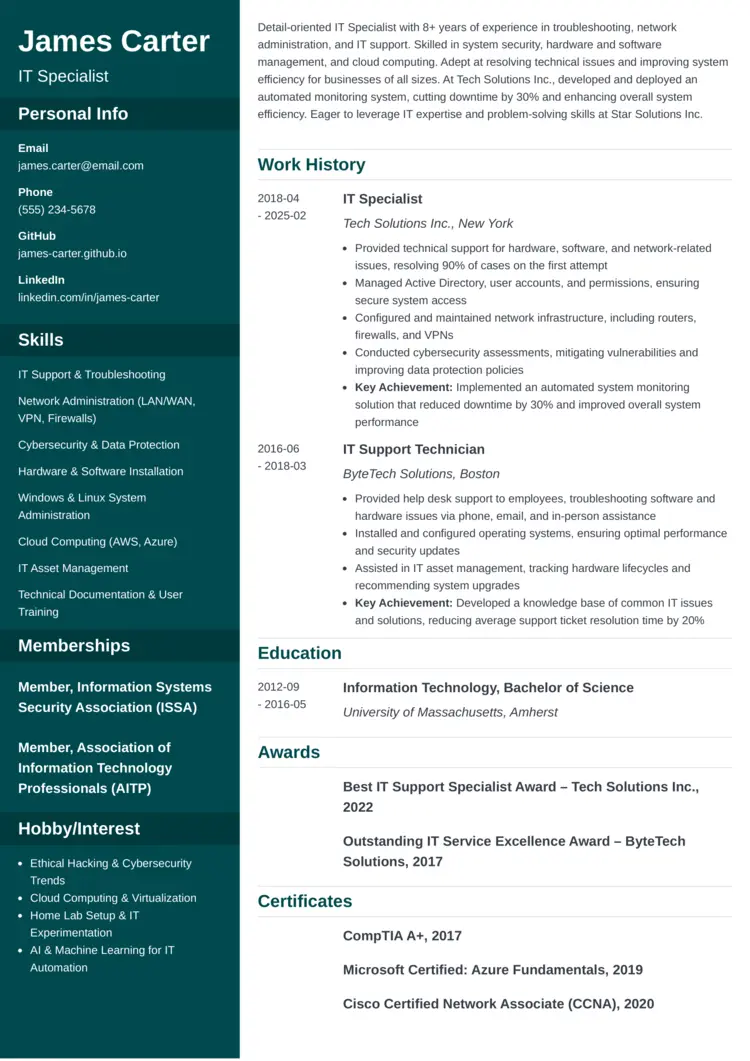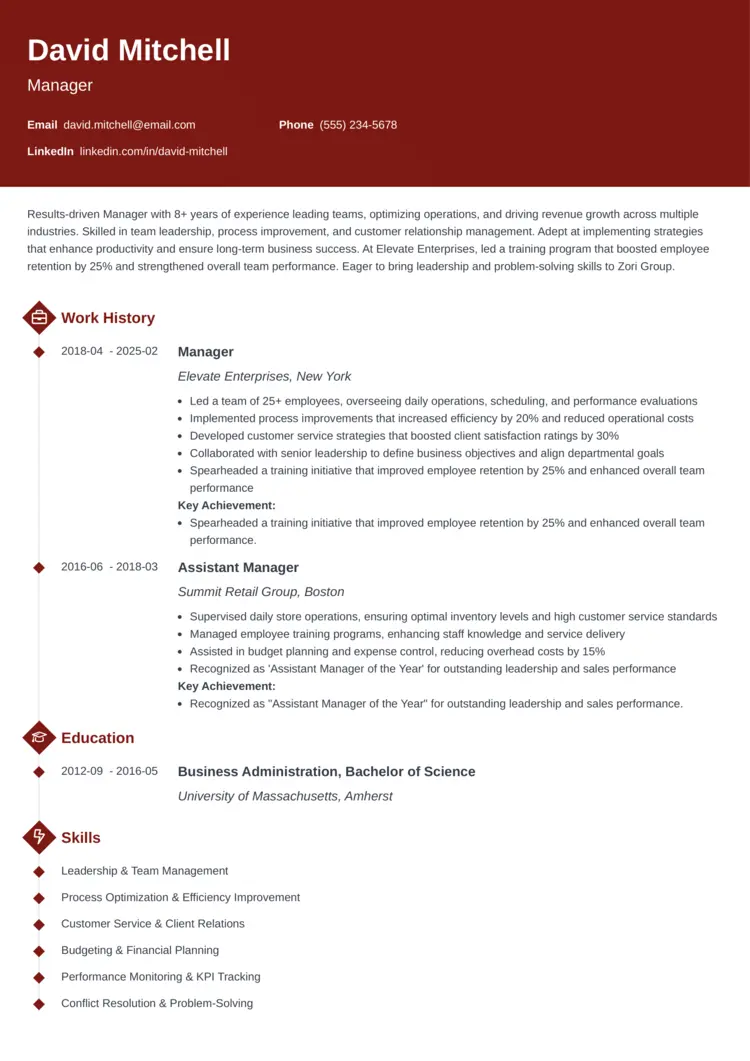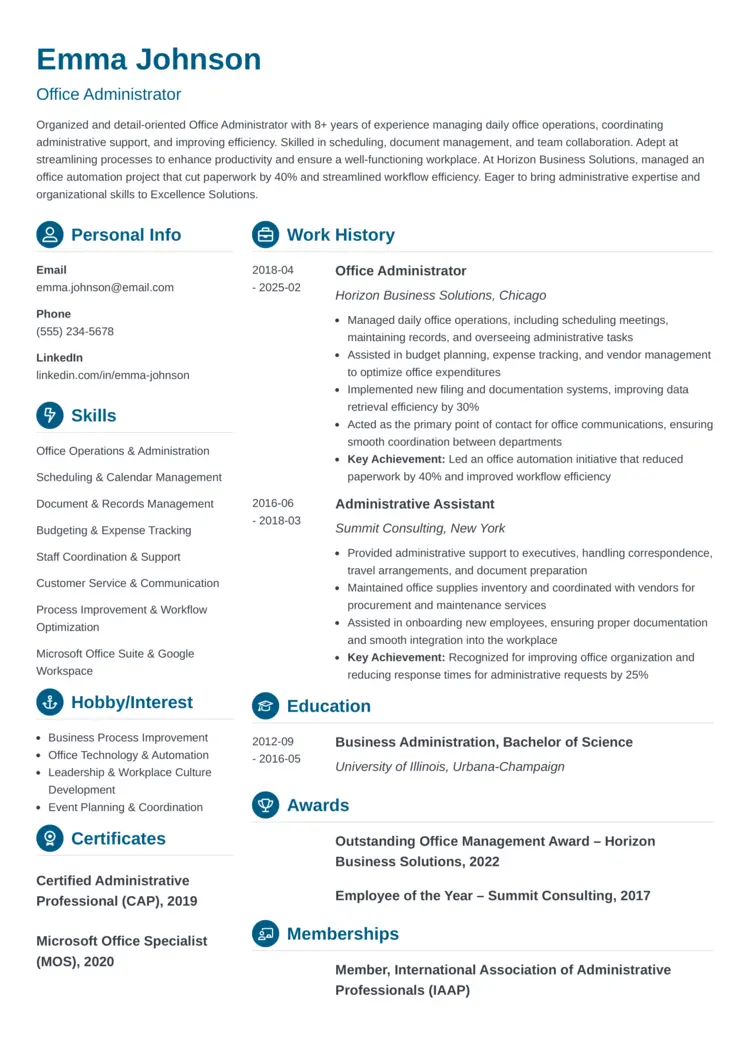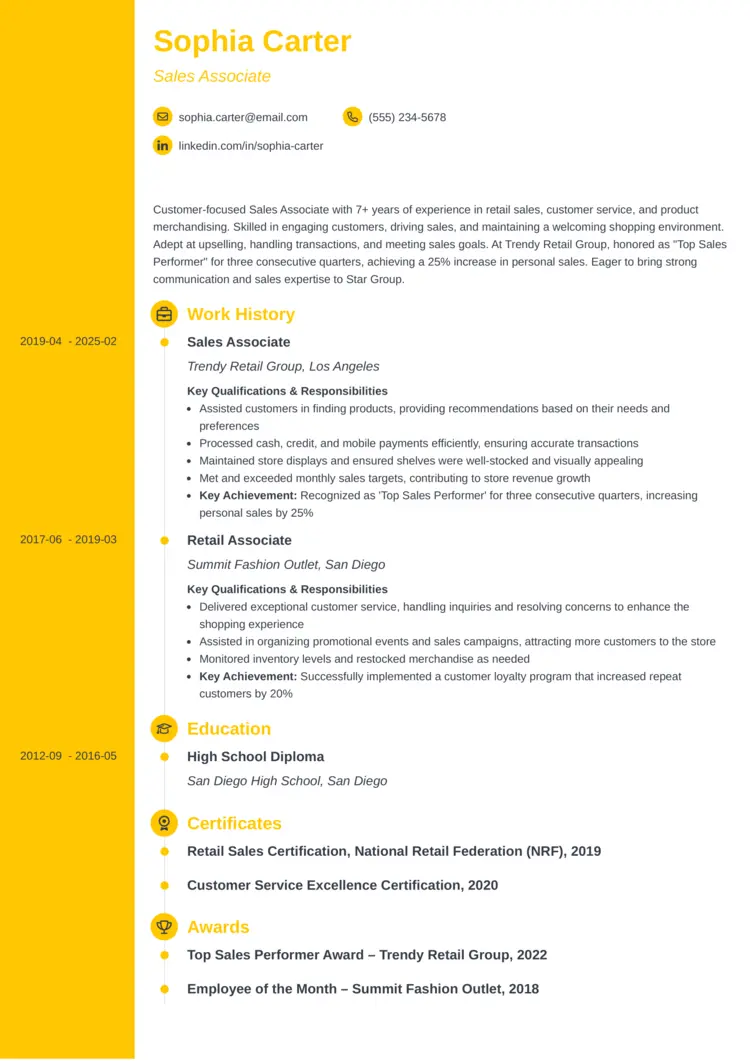How to Make a Resume: Examples & Guide for 2025
Create Your Resume NowHow to write a resume that gets results? By working smarter, not harder. When you know exactly how to make a resume, creating a great one takes less time than an episode of your favorite show. In fact, Zety’s report shows our users spend just 15.25 minutes writing a resume! In this guide, I’ll show you step-by-step how to build a resume that attracts the recruiters like a magnet. Let’s make every second count in your resume-writing journey!
How to Write a Resume for a Job: Quick Summary
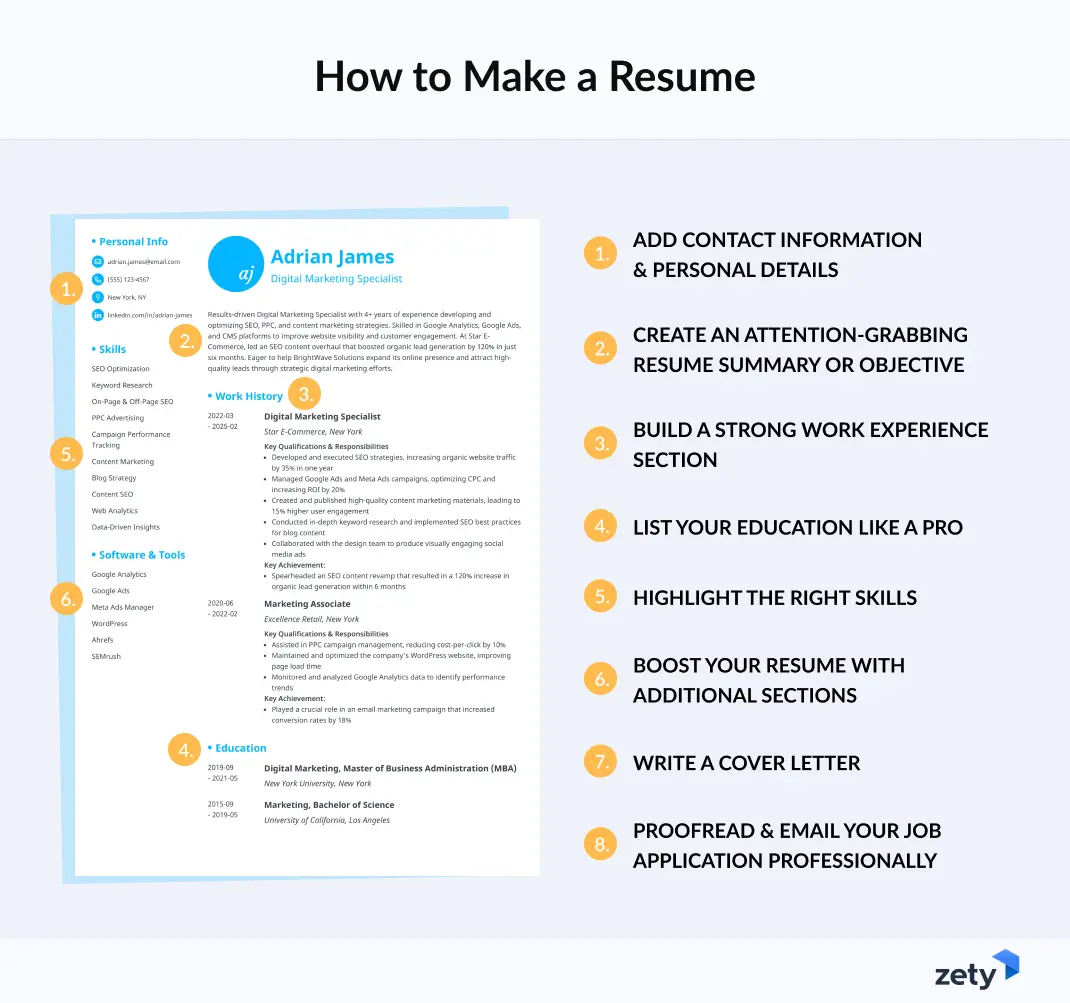
Before diving into the details of how to make a resume, take a look at the TL;DR take on the essential steps of resume writing:
- Gather Your Career and Education Details: Prepare your work history, achievements, skills, education, and any certifications or volunteer work in advance to streamline the resume-writing process.
- Choose the Right Resume Format: In most cases, use the reverse chronological format; opt for a functional resume layout for career changes or a combination resume style if you need to highlight both skills and experience.
- Add Contact Information and Personal Details: Include your name, job title, phone number, professional email, and LinkedIn profile, but skip unnecessary details like your home address or a photo.
- Start With a Resume Summary or Objective: Use a summary if you have experience and want to showcase achievements; use an objective if you’re entry-level and want to highlight potential.
- Create a Great Work Experience Section: List jobs in reverse-chronological order, include quantifiable achievements, and tailor descriptions to the job ad using action verbs and relevant keywords.
- List Your Education Like a Pro: Include degree, school name, and graduation year; for recent grads, add relevant coursework, honors, or extracurricular activities.
- Put Relevant Skills That Fit the Job Ad: Prioritize hard and soft skills that match the job description, keeping the list concise and relevant.
- Include Additional Resume Sections: Strengthen your resume with certifications, languages, projects, volunteer work, or memberships to stand out.
- Complement Your Resume With a Cover Letter: 83% of hiring managers find cover letters important, so craft one that highlights your enthusiasm and key achievements.
- Proofread and Email Your Resume the Right Way: Check for typos, save as PDF, use a professional file name, and personalize your email before sending your application.
Sounds like a lot? Don’t worry—I’ve got you covered. Keep reading, and I’ll break down each step to help you create a resume that makes recruiters want to invite you to a job interview.
If you prefer a video format, here’s a great one in which one of our Certified Professional Resume Writers, Caio, explains how to make a resume using our builder.
How to Make a Resume for a Job: Step-by-Step Guide
1. Prepare Your Career and Education Information
Before you dive into how to make a resume, collect all the essential details about your work history, education, and achievements. This step makes resume writing smoother and ensures you won’t miss key information.
Here’s what to prepare for how to make a professional resume:
- Job experience: List past and current roles with job titles, employer names, locations, dates, and key responsibilities.
- Achievements: Highlight work or academic successes, using numbers to show impact.
- Skills: Include both technical and soft skills relevant to the job.
- Education: Add your degree, school name, graduation year, and honors.
- Certifications & Awards: Mention titles, issuing organizations, and dates.
- Volunteer work & Extracurriculars: List organizations, roles, dates, and duties.
By preparing these details, you’ll make resume writing faster and more effective—ensuring you know how to make a good resume for a job that impresses employers.
Pro Tip: You might be tempted to write your resume in ChatGPT. While AI can be helpful, you still need to put a lot of work to make it right.
2. Format Your Resume Correctly
Once you have all the details, you should decide how to organize them on your resume. The reverse-chronological format is the most popular and the one you should use in 90% of cases, as it highlights your most recent experience first and clearly showcases your career progression.
However, depending on your situation, you might consider other resume formats:
- Functional resume: A skills-based format where the skills summary takes priority over work history. Used for writing a creative resume or transitioning to civilian with a military resume.
- Combination resume: A hybrid format that balances both skills and experience. It’s best for professionals with a vast amount of relevant experience in career change resumes and for covering employment gaps if you wish.
Understanding these formats will help you choose the right one when writing your resume and present your qualifications in the most effective way.

The chronological format is the most popular, but knowing how to make a professional resume also means you should follow these key rules:
- Margins & Spacing: Set 1-inch resume margins on all sides with single or 1.15 line spacing.
- Font: Use a clear, legible resume font like Calibri or Verdana, 10–12 pt for text, and 13–14 pt for headings.
- Resume Length: A one-pageresume is ideal, but a two-page resume will work better for extensive experience.
- Resume Header: Include your name and contact details at the top.
- Resume Sections: If you’ve chosen the chronological resume layout, arrange the sections in this order: profile, work experience, education, skills, and extra sections.
- Bullet Points: For clarity, limit the bullet points in your resume to six per section entry. Resume icons are optional.
- File Format: Check the job ad for preferred formats (PDF or .docx), but if no preferred one is mentioned, save your resume as a PDF to preserve its layout.
- File Name: Name your resume Job-Title-Resume-Your-Name.pdf for clarity.
Pro Tip: Consistency is key in resume writing—format dates the same way throughout to maintain a polished look.
3. Add Contact Information and Personal Details
Your contact information is the first thing employers see on your resume, so keeping it clear, professional, and relevant is key to writing a professional resume.
Here’s what to include and what to skip when making a resume:
✅ Include:
- Full Name: Start with your first and last name.
- Job Title: Use your current or most recent job title.
- Phone & Email: Provide a professional email address (avoid casual ones like “[nickname]@gmail.com”).
- LinkedIn Profile: A link to an optimized LinkedIn profile is a great addition to a well-written resume, especially since, according to the Employ Recruiter Nation Report 2024, LinkedIn is the leading social platform for recruitment, with 71% of recruiters already using it or planning to do so.
- Personal Website: Add one if relevant (e.g., portfolio, blog).
❌ Skip:
- Home Address: Including a home address on a resume is unnecessary for most applications.
- Date of Birth: Avoid potential age bias.
- Photo: Not required in the US unless applying for acting or modeling jobs.
Take a look at how you can present your personal details and contact information when writing a resume:

Pro Tip: Before hiring managers look you up, sanitize your online presence. Remove inappropriate content and update your LinkedIn to ensure it matches your resume.
4. Benefit From a Resume Summary or Resume Objective
According to our HR statistics report, recruiters spend just 7 seconds scanning a resume—so the top section is prime real estate. And that’s where a resume summary or objective statement should be.
Unfortunately, most job seekers aren’t aware of the importance of a well-written resume profile—only 38.11% of resumes created in our builder in 2024 featured this section. This means that you can gain a significant competitive advantage just by writing a resume summary or a resume objective.
But first—what’s the difference between these two types of resume introduction?
- Resume Summary: Best for candidates with 1+ years of experience. This 2–3 sentence paragraph highlights your key achievements and skills, making it clear why you’re a strong fit.
- Resume Objective: Ideal if you have little or no relevant experience. Instead of focusing on past roles, it emphasizes your skills, ambitions, and what you can contribute to the company.
Want to know how to write a good resume profile that grabs attention? Follow these simple formulas:
Resume Summary Formula

Objective Statement Formula
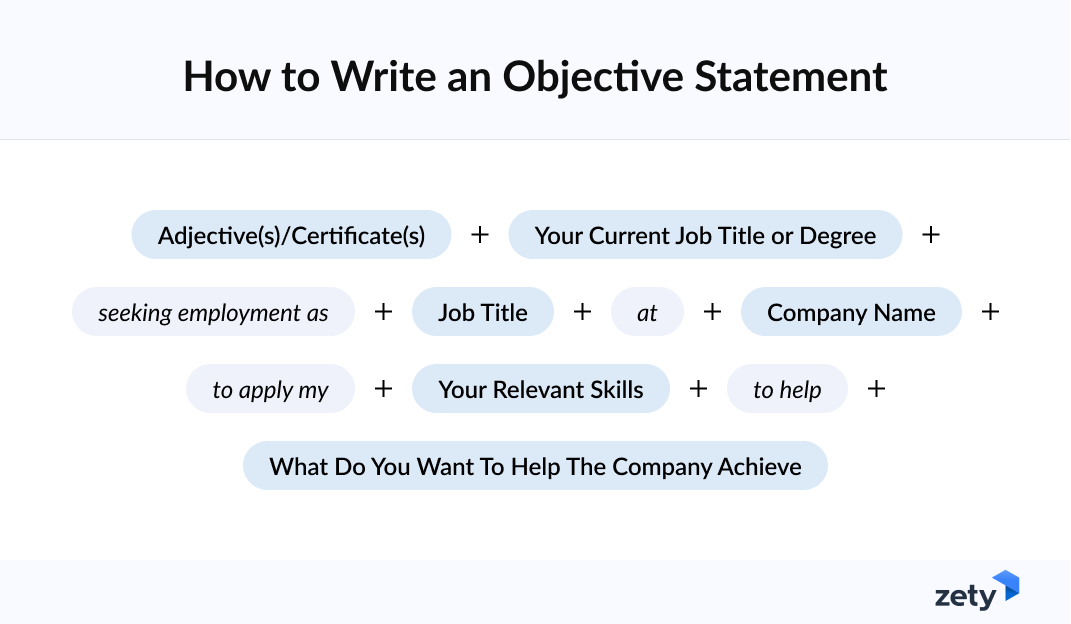
Now, I’ll show you how to write a professional resume summary with right and wrong examples for clarity:
Resume Summary Example
| Right |
|---|
| Results-driven sales manager with 8+ years of experience leading high-performing teams and surpassing revenue targets. Increased regional sales by 35% in two years and implemented a customer retention strategy that boosted repeat business by 20%. Eager to bring strategic leadership and growth-focused insights to the Apex Sales team. |
This summary highlights quantifiable achievements, demonstrating the candidate’s ability to drive sales and lead a team. It’s tailored to the company and showcases specific contributions rather than generic skills.
| Wrong |
|---|
| I have worked in sales for several years and know how to manage a team. I am good at customer service and always try to meet targets. I am looking for a new challenge in a growing company. |
Unfortunately, this example is too vague and doesn’t offer any concrete achievements. Instead of stating general skills, a strong resume summary should emphasize measurable impact and unique value.
Now, let's look at another set of right and wrong examples for writing a resume objective:
Resume Objective Example
| Right |
|---|
| Motivated recent marketing graduate with a strong foundation in digital campaigns and content strategy. Completed an internship at BrandX, where I increased social media engagement by 40%. Excited to apply creativity and analytical skills to drive brand growth at Horizon Media. |
This objective works because it focuses on relevant skills and achievements despite limited experience. It also mentions a past accomplishment with data, making it more compelling.
| Wrong |
|---|
| I am a marketing graduate looking for an entry-level job. I have studied digital marketing and am passionate about social media. I am hardworking and eager to learn. |
I’m sure you can tell that this candidate clearly has no idea how to write a perfect resume objective. This version lacks specificity and impact. While enthusiasm is important, the candidate should provide real examples of skills or achievements to make their resume stand out.
Pro Tip: If you have enough experience, consider writing a summary of qualifications instead.
5. Design a Strong Work Experience Section
Your work experience section is one of the most critical parts of your resume. In fact, according to our 2025 Future of Work Report, 37% of recruiters check this section first. If you want to know how to write a resume for a job that gets you noticed, you need to present your experience strategically.
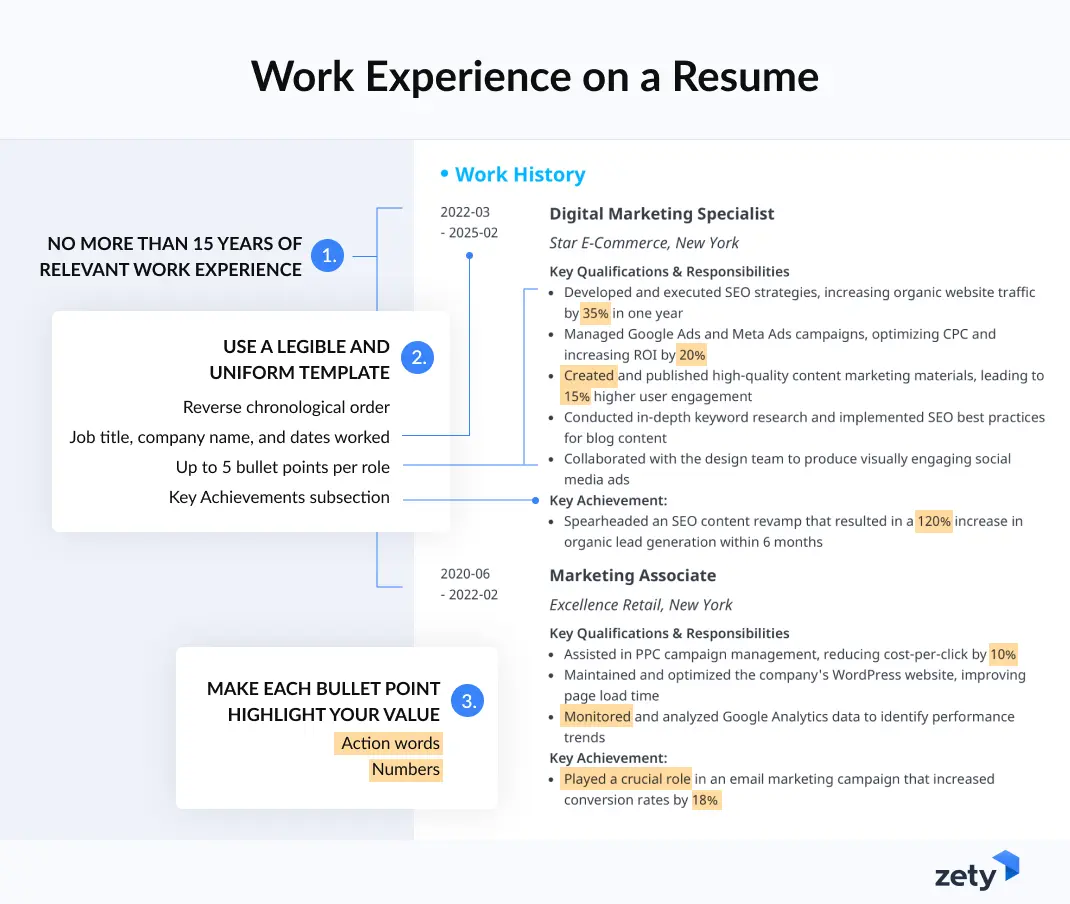
Use Coherent Formatting for Each Work Experience Entry
Here’s how to format the entries in your resume’s work experience section:
- Job Title: Start each entry with your job title, placing it at the top in bold to make it easy to scan.
- Company Name & Location: List the company name, followed by the city and state (or just the country if applying internationally).
- Employment Dates: Use months and years to indicate the duration of your employment (e.g., March 2021–February 2025). There’s no need to include exact days.
- Key Responsibilities: List 5–6 main duties that align with the job you’re applying for. Use present tense for your current job and past tense for previous roles.
- Key Achievements: Show how well you performed, not just what you did. Use action verbs and add numbers where possible to highlight impact.
Now check out some of the action verbs you can use to make your resume more compelling:
Resume Action Words | ||
|
|
|
Tailor Your Work Experience to the Job Description
If you want to know how to create a resume that gets noticed, tailoring your resume’s work experience section to the job description is key. This means using keywords from the job ad to create an ATS-friendly resume that gets approved by the applicant tracking systems.
Many companies use ATS software to scan resumes and assign a score based on relevant keywords. The more relevant terms your resume includes, the higher your chances of landing in front of a recruiter.
Go through the job description and identify keywords for your resume related to:
- Duties (e.g., coordinate marketing campaigns, manage client accounts)
- Skills (e.g., project management, digital marketing, PR)
- Qualifications (e.g., 4+ years of experience, business-related degree)
- Qualities (e.g., strong analytical mindset, creative problem-solver)
When creating your work history section, incorporate or refer to as many of the elements mentioned above as possible in your responsibilities and key accomplishments.
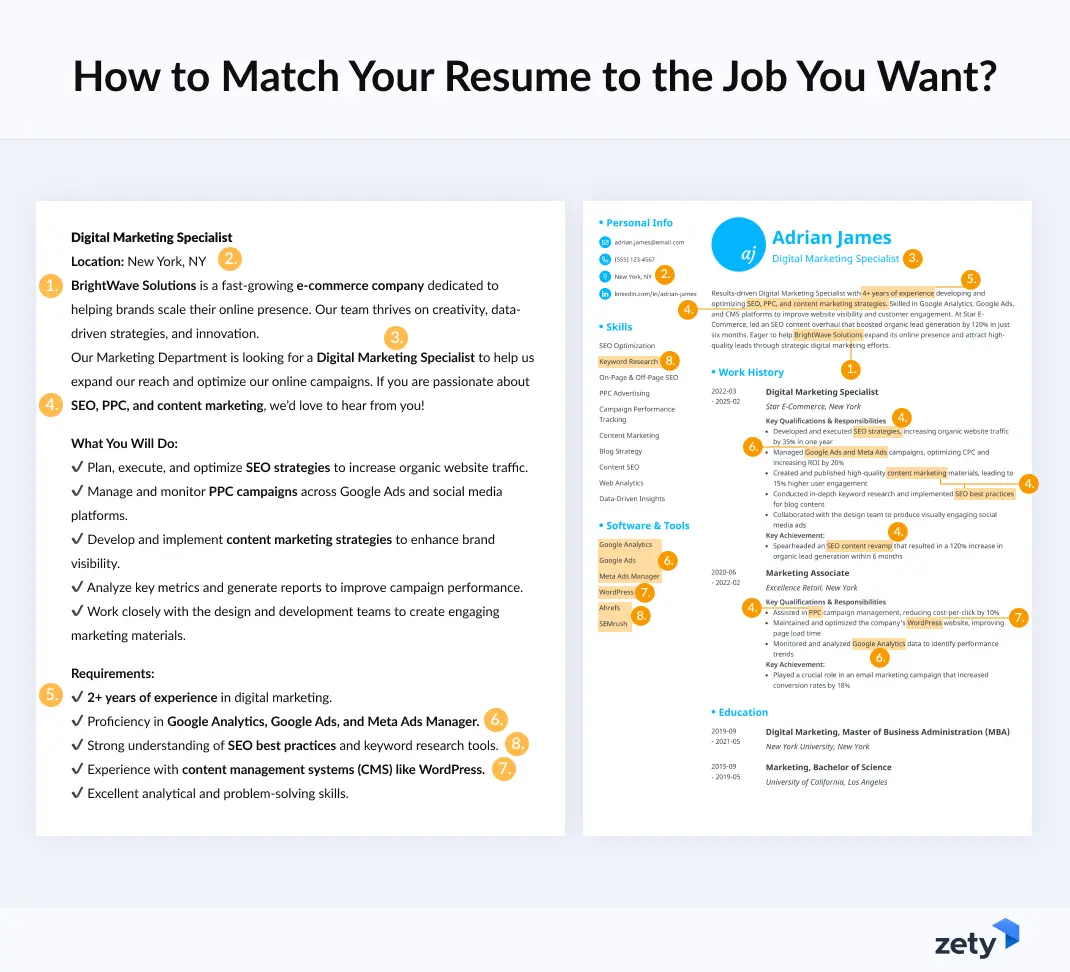
Consider How Much Work Experience to Include
One common mistake when writing a resume is including too much or too little work experience. The general rule is that a resume should go back at most 10–15 years, focusing on the most relevant roles. However, the amount of detail you include depends on your experience level.
- No experience? Include internships, volunteer work, or student leadership roles to showcase transferable skills.
- Entry-level candidates should list all paid work, emphasizing relevant responsibilities and achievements.
- Mid-level professionals should describe key roles in detail, summarizing less relevant positions.
- Senior-level applicants should focus on up to 15 years of experience and use strong action verbs to highlight leadership and impact.
Creating a resume with our builder is incredibly simple. Follow our step-by-step guide and use content from Certified Professional Resume Writers to have a resume ready in minutes.
When you’re done, Zety’s resume builder will score your resume and our resume checker will tell you exactly how to make it better.
6. Present Your Educational Background
Many job seekers underestimate the importance of the education section, but when learning how to make a professional resume, you’ll realize it’s a key element that proves your qualifications. Even if you have extensive work experience, this section adds credibility to your background.
List your education details in this order:
- Degree: Start with your highest degree (leave out high school if you have a college degree).
- University Name & Location: Clearly mention where you studied.
- Dates Attended: Include the month and year (exact days aren’t necessary).
If you have limited work experience, you can expand this section by including:
- Completed credits if your degree is unfinished.
- Relevant coursework and major and minor to prove your subject knowledge.
- Latin honors or awards (e.g., Dean’s List) to highlight academic excellence.
- Extracurricular activities that demonstrate job-related skills.
- Academic projects or memberships (e.g., Phi Beta Kappa) to showcase engagement.
Education Section Example
| Right |
|---|
BA in Information Technology University of California, Los Angeles, CA September 2019–May 2024 3.9 GPA Minored in Cybersecurity Key Accomplishments:
|
This example follows the correct structure and highlights academic achievements, leadership, and relevant skills.
Pro Tip: Include your GPA only if it's 3.5 or higher and you’ve graduated recently. Never round it up—accuracy matters in resume writing. If your GPA isn’t strong, focus on honors, coursework, or extracurriculars instead.
7. Add Relevant Skills That Match the Job Requirements
Your skills section is one of the most crucial parts of your resume. When learning how to write a good resume, don’t forget about tailoring your skills to match the job ad. This not only makes your resume more relevant but also increases your chances of passing ATS scans and impressing recruiters.
There are two main types of skills to include:
- Hard Skills: These are technical abilities you’ve learned through training or experience, such as project management, software proficiency, or coding.
- Soft Skills: These are personal attributes that influence how you work, such as stress management, communication skills, and collaboration skills.
A well-balanced mix of hard and soft skills makes your resume stronger and more compelling by showcasing both technical expertise and interpersonal strengths.
Here’s a step-by-step process to ensure you include the most relevant ones:
- Create a Master List: Write down all your hard and soft skills without filtering them yet.
- Analyze the Job Ad: Look for skills explicitly mentioned in the job description.
- Research the Company: Check the company’s website, social media, and LinkedIn to identify additional desired skills.
- Compare Both Lists: Identify overlapping skills between your master list and the job ad/company research.
- Select the Top 10: Choose up to 10 most relevant skills to include on your resume.
By tailoring your skills section this way, you’ll create a resume that aligns perfectly with the job requirements, increasing your chances of getting noticed.
One last tip about your professional skills: upskilling is no longer just a good idea—it’s essential. With 39% of the workers’ current skills expected to become outdated by 2030, according to the latest report by the World Economic Forum, keeping up is more crucial than ever. Fortunately upskilling is also easier than ever with platforms like Coursera and Udemy.
Interestingly, analytical thinking is the #1 soft skill (or "power skill" in today’s AI-driven world) that 70% of employers are prioritizing for 2025. Yet Zety’s analysis reveals that it’s missing from the top 10 soft skills most often added to resumes. This means that including analytical skills when writing a resume is a simple but powerful way to stand out.

8. Boost Your Resume with Bonus Sections
A standard, professional resume covers work experience, education, and skills, but how to make a resume that grabs attention like a magnet? By adding extra sections that showcase your unique qualifications.
Here are some additional sections to consider when making a resume:
- Awards & Recognitions: Show that you’re a top performer.
- Certifications & Licenses: Verify your expertise in specific areas.
- Professional Memberships: Demonstrate industry engagement.
- Language Skills: Highlight multilingual abilities for diverse work environments.
- Publications & Appearances: Establish yourself as an expert in your field.
- Projects: Showcase key accomplishments and problem-solving skills.
- Conferences: Prove your commitment to continuous learning.
- Hobbies & Interests: Add a personal touch while demonstrating soft skills.
- Volunteer Work: Studies show it boosts employability by proving dedication and teamwork.
Pro Tip: Should you include references on your resume? Most experts say no—hiring managers will request them later if needed. Instead, use that space for stronger content.
Plus, a great cover letter that matches your resume will give you an advantage over other candidates. You can write it in our cover letter builder here. Here's what it may look like:
See more cover letter templates and start writing.
9. Proofread and Send Your Resume
You’ve written a great resume, but before hitting send, make sure it’s polished and professional. Follow these best practices to ensure your resume is perfect:
- Review Your Resume: Ensure all sections are present and properly formatted.
- Double-check for Completeness: Make sure your resume includes everything needed to showcase your qualifications.
- Scan for Errors: Use a tool like Grammarly to catch typos and grammar mistakes.
- Get a Second Opinion: Ask a friend or colleague to review your resume for clarity.
- Personalize Your Email: Address the hiring manager by name instead of using To Whom It May Concern.
Read more: 10+ Email Examples for Emailing a Resume
Job-Specific Resume Examples for Inspiration
Now that you know how to create a good resume, let’s see what the results can look like! Below are professional resume examples from Certified Professional Resume Writers. Use them as inspiration when writing your own resume.
1. IT Specialist Resume Example
Read more: See the full guide for an IT Specialist Resume
2. Manager Resume Example
Read more: See the full guide for a Manager Resume
3. Office Administrator Resume Example
Read more: See the full guide for an Office Administrator Resume
4. Sales Associate Resume Example
Read more: See the full guide for a Sales Associate Resume
If your job isn’t on the list, don’t worry! Here are more resume examples tailored to different experience levels and industries.
- Resume With No Experience
- Teen Resume
- Student Resume
- College Application Resume
- College Student Resume
- Internship Resume
- Resume for a Part-Time Job
- Entry-Level Resume
- Resume With Employment Gaps
- Federal Resume
- US Resume
- Canadian Resume
And if you’re an international reader, you can also switch over to:
Pro Tip: Did you know that while a resume is called a resume in the US and Canada, most of the world refers to it as a curriculum vitae (CV)? What’s more, the terms are often used interchangeably in South Africa, India, New Zealand, and Australia. Learn more about the key differences between a resume and a CV.
Expert Tips on How to Make a Resume
When writing a resume, there are some things that you simply can’t forget about. Take a look at these expert tips below to discover the ultimate best practices of professional resume writing:
"A generic resume won’t get you far in today’s job market. Tailoring your resume to each job application shows employers you’ve done your homework and highlights how your skills match their specific needs. This small effort can make a huge difference in landing interviews."
"Recruiters spend mere seconds on an initial resume scan, so keeping it concise is crucial. A well-structured template helps you format your resume efficiently, ensuring it stays within the ideal length—one page for less-experienced candidates and up to two pages for seasoned professionals."
"Your resume isn’t a biography—it’s a marketing tool. Prioritize experience and skills that align with the job you’re applying for. This keeps your resume impactful and makes it easier for recruiters to see why you’re the right fit.
Read more: The Best Expert Tips for Writing Your Resume
Boost Your Chances With a Cover Letter That Gets You Noticed
Think cover letters are a thing of the past? Think again. A staggering 83% of hiring managers say a strong cover letter is important to their hiring decisions. Yet, many candidates skip this step—giving you a golden opportunity to stand out.
While your resume lists your qualifications, a cover letter brings them to life. It allows you to tell your story, showcase your enthusiasm, and connect with the employer on a personal level. To make an impact, follow these key steps:
- Tailor your cover letter just like your resume, making it as relevant to the job ad as possible.
- Start your cover letter with a strong introduction to grab the reader’s attention
- Mention the company’s name and highlight your relevant achievements.
- Explain why you are the perfect fit for this position.
- End with an enthusiastic cover letter conclusion with a powerful call to action, ideally offering a specific date for your interview.
- Keep the correct cover letter length. Don’t submit anything longer than a page.
Read more: How to Write a Cover Letter: The Ultimate Guide for 2025
Key Takeaways
Writing a good resume involves more than just listing your experience. Here’s a recap of how to make a resume:
- Gather all relevant career, education, and training details.
- Choose the right format to highlight your strengths.
- Keep contact details professional and up to date.
- Start with a compelling summary or objective to grab attention.
- Showcase key responsibilities and achievements in your work experience.
- Include relevant coursework, honors, and activities in your education section.
- Tailor your hard and soft skills to match the job requirements.
- Boost your resume with extra sections like certifications or awards.
- Pair it with a strong cover letter to reinforce your key qualifications.
- Proofread carefully and follow application instructions exactly.
Thanks for reading, and best of luck with writing your resume! Do you have any more questions on how to make a great resume? Not sure how to build a resume work experience section or how to prepare a resume list of skills or achievements? Drop a comment below—I’m happy to help!
About Zety’s Editorial Process
This article has been reviewed by our editorial team to make sure it follows Zety's editorial guidelines. We’re committed to sharing our expertise and giving you trustworthy career advice tailored to your needs. High-quality content is what brings over 40 million readers to our site every year. But we don't stop there. Our team conducts original research to understand the job market better, and we pride ourselves on being quoted by top universities and prime media outlets from around the world.
Sources
- Central Connecticut State University, "The Ultimate LinkedIn Cheat Sheet"
- Das.iowa.gov, "Drafting Essential Functions"
- Christopher Spera, Ph.D.; Robin Ghertner, M.P.P.; Anthony Nerino, M.A.; Adrienne DiTommaso, M.P.A., "Volunteering as a Pathway to Employment: Does Volunteering Increase Odds of Finding a Job for the Out of Work?"
- Human Resources Online, “Are cover letters important? 83% of recruiters say yes”
- World Economic Forum, “Future of Jobs Report 2025”
- Jobvite, “Employ Recruiter Nation Report 2024”
- Harvard Business School, “Transferable Skills”



